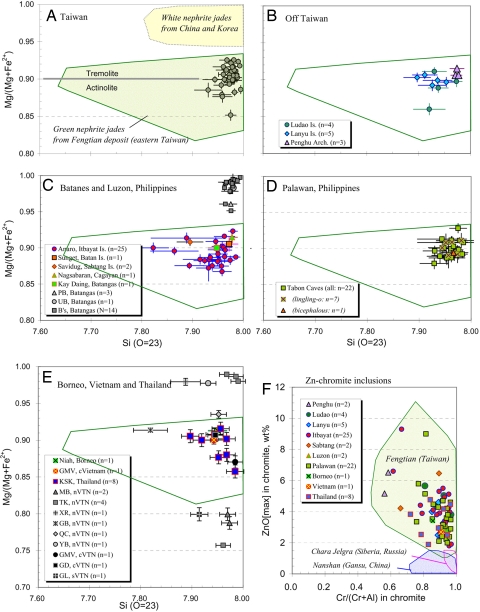Fig. 4.
Chemical compositions of nephrite jade artifacts. (A–E) Chemical compositions of the nephrite jade matrices of studied artifacts from Taiwan (A and B), the Philippines (C and D), and Borneo, Vietnam, and Thailand (E). The x and y axes represent, respectively, Si (atoms per formula unit on the basis of 23 oxygen) and Mg/[Mg+Fe2+] ratios, with the ideal chemical formula of calcium amphibole (Ca2[Mg,Fe]5[Si,Al]8O22[OH]2). Relative standard deviations (1σ) of measurements are shown as error bars. (A) Symbols represent the WDS-EPMA results for 42 artifacts from 17 Taiwan sites. The upper shaded area encloses the chemical compositions of white-colored nephrite jade deposits from China (Liaoning, Xinjiang, Gansu, and Jiangsu Provinces) and Korea (Chuncheon) (11–13). The lower shaded area represents the chemical compositions of green nephrite jade raw materials from the Fengtian deposit (eight hand specimens) and a nearby riverbed (nine hand specimens) in eastern Taiwan (11). The chemical boundary between tremolite and actinolite is marked by the Mg/(Mg+Fe) ratio of 0.90 (SI Table 3). (B–E) Analytical results obtained by the noninvasive LVSEM-EDS technique. The enclosed areas delimit the range of chemical compositions for Fengtian green nephrite jades. (B) Yugang and Guanyindong on Ludao Island, Lanyu High School on Lanyu Island, and Liyushan (Wangan Island) and Nangang (Qimei Island), Penghu Archipelago (12 artifacts from five sites, SI Table 4). (C) Anaro on Itbayat Island, Sunget on Batan Island, Savidug on Sabtang Island, Nagsabaran in the Cagayan Valley, and Kay Daing in Batangas, northern Philippines (30 artifacts from five sites) (SI Tables 4 and 5). The white nephrite (tremolite) artifacts from Uilang Bundok (UB: 1 adze) and Pila (PB: 3 adzes) in Batangas, and 12 adzes and two preforms from H. Otley Beyer's 1940s Batangas collection in the National Museum of the Philippines, are shown as gray symbols. In terms of their mineral chemistry and archaeological contexts, the white nephrites in the Philippines are probably of local origin (14) (SI Table 7). (D) Tabon Caves, Palawan (22 ornaments from nine sites: see SI Table 6). Seven lingling-o penannular earrings with three pointed circumferential projections and a single bicephalous (double-headed) animal ear pendant are plotted. (E) Artifacts from Niah Cave (Sarawak), Go Ma Voi (GMV) (central Vietnam), and Khao Sam Kaeo (KSK) in peninsular Thailand are represented here, including the lingling-o penannular earrings with three pointed circumferential projections from Niah and GMV (10 ornaments and worked pieces from three sites: see SI Table 4). White to green nephrite artifacts from northern Vietnam (MB, Man Bac; TK, Trang Kenh; XR, Xom Ren; GB, Go Bong; QC, Quy Chu; YB, Yen Bac), from central Vietnam (GMV; GD, Go Dua), and from southern Vietnam (GL, Giong Lon), shown by gray and black symbols, are not of Fengtian nephrite in terms of their mineral chemistry (see SI Table 7). (F) Chemical compositions of zinc-bearing chromite ([Mg,Fe,Zn][Al,Cr]2O4) inclusions in the surfaces of nephrite artifacts, analyzed by the noninvasive LVSEM-EDS technique. Symbols represent the value for zinc oxide (ZnO in wt %) and the Cr/(Cr+Al) ratio for each artifact. Because the chromite in Fengtian nephrite jade bears significant amounts of zinc (2 to 11 wt % in ZnO) (11) in comparison with the other possible nephrite (actinolite/tremolite) jade sources tested (Chara Jelgra, Siberia and Nanshan, Gansu), the Zn content provides a good clue for the identification of Fengtian nephrite.

